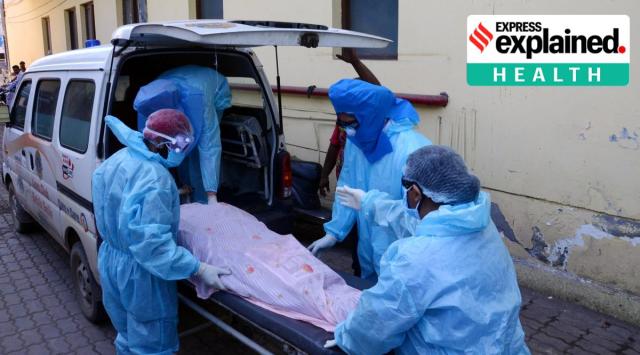- India
- International
Explained: The death data in CRS, and why they do not tell the full story of India’s Covid-19 toll
There has been unusually high interest in the CRS data for 2020, especially the death numbers contained therein, because of the large number of deaths caused by the pandemic. About 1.49 lakh people died due to Covid-19 in 2020, according to official figures.
 Healthcare workers in protective gear carry the body of a Covid-19 victim in Amritsar. (Express Photo: Rana Simranjit Singh, FIle)
Healthcare workers in protective gear carry the body of a Covid-19 victim in Amritsar. (Express Photo: Rana Simranjit Singh, FIle)New data from the office of the Registrar General of India show that about 4.75 lakh more deaths were registered in the country in 2020 compared to the previous year. The data are part of information contained in the Civil Registration System (CRS) for 2020 that was released on Tuesday (May 3).
There has been unusually high interest in the CRS data for 2020, especially the death numbers contained therein, because of the large number of deaths caused by the pandemic. About 1.49 lakh people died due to Covid-19 in 2020, according to official figures.
However, this number is widely believed to be an undercount. Several academic studies have estimated a much higher number of Covid-19 deaths in India. But these estimates have been arrived at using indirect methods, involving multiple layers of assumptions and extrapolations.
A more definitive picture of Covid-19 deaths in India was expected to emerge from the numbers contained in the CRS, which has registered births and deaths, and another, separate exercise called the Sample Registration System (SRS) that relies on a regular survey-based process to estimate the total number of births and deaths in the country.
CRS presents a count of registered births and deaths, while SRS provides an estimate of the total number births and deaths. The CRS data, therefore, is a subset of the SRS numbers.

Over the years, there has been a steady increase in the registration of births and deaths. More than 90 per cent of births and deaths are now getting registered, with several states reporting more than 98 per cent registrations. In other words, CRS data are slowly converging towards SRS numbers.
What do the CRS data say about Covid-19 deaths?
The CRS data released on Tuesday do not throw any new light on the number of Covid-19 deaths in the country in 2020. CRS is a record of all-cause deaths (and births). It does not categorise deaths by causes.
What the latest CRS data have revealed is that 81.16 lakh deaths were registered in India in 2020, and that this was an increase of about 4.75 lakh over the previous year. The 81.16 lakh registrations in 2020 would obviously include deaths caused by Covid-19 as well, but as of now we do not know the number of those deaths.
 There was a 6.21% rise in deaths from 2019 to 2020.
There was a 6.21% rise in deaths from 2019 to 2020.
So how have registrations increased?
It is important to note that what has increased is the registration of deaths. We do not know as of now whether the actual number of deaths in 2020 has increased as well, and by how much. As mentioned earlier, the estimate for the total number of deaths (and births) is provided through the Sample Registration System, or the SRS. And the SRS data for 2020 are still not available.
The increase in death registrations in 2020 is consistent with the recent trend. Registration of both births and deaths has increased significantly in the last few years.
In 2019, for example, 92.7 per cent of all estimated births, and 92 per cent of all estimated deaths in the country were registered. Just two years earlier, in 2017, these numbers were significantly lower. In 2017, only 83.5 per cent of all estimated births and 78.3 per cent of all estimated deaths were registered.
 The increase in death registrations in 2020 is consistent with the recent trend.
The increase in death registrations in 2020 is consistent with the recent trend.
The increase of 4.75 lakh death registrations, a rise of about 6 per cent, is in fact, not unusual. In the previous year, death registrations had increased by more than 6.9 lakh, an almost 10 per cent jump over 2018. Even in 2018, death registrations had increased by over 4.86 lakh. This trend has been continuing for over a decade now, though the year-on-year rise used to be smaller earlier.
A similar trend is visible in the registration of births as well. The percentage of total estimated births that get registered is showing an upward trend. But the actual number of registrations dropped in 2020 to 2.42 crore from 2.48 crore in 2019. This could be because of the fall in the total number of births. If fewer babies are being born, the total number of registrations are also expected to go down, even while the percentage of registrations continues to rise.
Why are registrations rising?
There could be a variety of reasons for the rising trend in registrations of births and deaths. Greater awareness, legal mandate, and access to benefits and services could all be playing a role in this.
Aadhaar, the increase in the number of bank accounts, and the network of government services that are linked to these provide the incentive, and sometimes make it necessary, for people to get births and deaths registered. These are probably the reasons why registrations have seen a very sharp and unprecedented increase in the last three years.
However, now that more than 92 per cent of births and deaths are getting registered, the room for a sharp year-on-year increase, the kind of which was seen in the previous three years, is limited. Registrations are likely to grow at much slower pace now. However, at the state level, there is still scope for massive improvements. In Bihar, for example, only 52 per cent of all estimated deaths in 2019 was registered. Uttar Pradesh is in a similar situation with 63 per cent death registrations in 2019.
How will we know the Covid-19 death count?
The SRS data, when they come out, are expected to give a fairly accurate estimate of Covid-19 deaths in the country.
Like CRS, the SRS also does not categorise deaths by cause. But it tries to estimate the total number of deaths in the country every year.
If the total number of deaths in 2020 is found to be significantly higher than previous years, it can be assumed to have been influenced by Covid-19 deaths.
According to SRS data for previous years, about 83.5 lakh people die in India on an average every year. The official Covid-19 death toll for 2020, about 1.49 lakh, would go unnoticed because it would be within the yearly variation. In 2011 and 2013, for example, more than 85 lakh people are estimated to have died in the country. The Covid-19 deaths can cause a bump in the yearly numbers only if the actual death toll is substantially higher than the official toll.
Newsletter | Click to get the day’s best explainers in your inbox
EXPRESS OPINION
Apr 24: Latest News
- 01
- 02
- 03
- 04
- 05









































